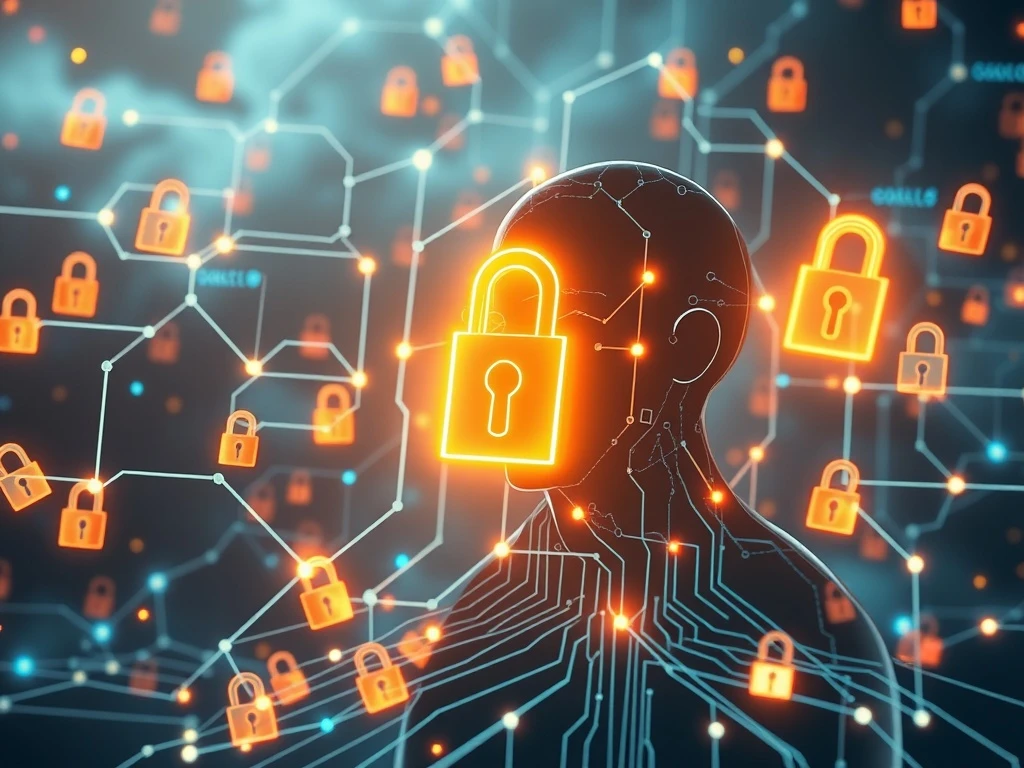Blockchain Digital Identity: A Revolutionary Shield Against Billions of Leaked Passwords

In an increasingly digital world, the security of our online lives is paramount. For anyone involved in the cryptocurrency space, this concern is amplified, as compromised digital identities can lead to the devastating loss of valuable assets. Imagine your seed phrase, private keys, or exchange login details falling into the wrong hands because of a seemingly unrelated data breach. This isn’t a hypothetical threat; it’s a stark reality, especially after the staggering revelation of 16 billion passwords leaked. This catastrophic event isn’t just a wake-up call for general internet users; it’s a direct challenge to the very foundation of how we secure our digital selves, including our crypto holdings. It begs the urgent question: Is it finally time for a fundamental shift to blockchain digital identity?
The Alarming Reality: Billions of Passwords Exposed
The year 2025 brought with it a chilling discovery that underscored the fragility of our current digital security landscape. Cybersecurity researchers at Cybernews unearthed one of the most significant credential leaks ever recorded: an astonishing collection of over 16 billion login details. These weren’t from a single, isolated incident, but rather a vast compilation of data from years of infostealer malware attacks. These malicious programs silently infiltrate devices, meticulously scraping sensitive information ranging from passwords and cookies to active session tokens and entire web login histories. What makes this leak particularly dangerous is that, unlike older data dumps, many of these credentials remain active and functional today.
The scale of this compromise is difficult to grasp. Major platforms like Google, Apple, Facebook, Telegram, and GitHub are all implicated, alongside various government systems. Some individual data sets within this massive leak contained as many as 3.5 billion records. For a period, much of this sensitive information was openly accessible on publicly exposed servers, requiring no hacking expertise to download. This accessibility alone is a critical point that demands attention. It highlights how easily malicious actors can acquire the tools for widespread fraud and identity theft.
Consider this: In 2024 alone, infostealer malware was responsible for 2.1 billion stolen credentials, accounting for nearly two-thirds of all credentials stolen by such tools that year. This trend indicates a persistent and evolving threat that traditional defenses struggle to contain.
Why Traditional Security Falls Short: The Imperative for Passwordless Authentication
The 16 billion password leak lays bare the inherent weaknesses of traditional identity systems that are still widely in use. At the core of the problem is human behavior and systemic design flaws:
- Password Reuse: Most people reuse passwords across multiple services. When one account is compromised, a domino effect can expose everything from your email to your banking and crypto exchange logins. This is the mechanism behind credential stuffing attacks: one leaked password can potentially unlock your entire digital life.
- Beyond Passwords: The danger extends beyond just passwords. Many of the leaked files included session tokens. These are essentially digital keys that grant access to already-authenticated accounts, bypassing the need for a password entirely.
- Malware-as-a-Service: The proliferation of readily available malware-as-a-service tools means attackers no longer need advanced skills or direct targeting. They can simply purchase stolen data and automate account takeovers.
This perfect storm creates an environment ripe for identity theft, financial fraud, and lasting privacy risks. It serves as a clear wake-up call that current defenses, including two-factor authentication (2FA) and password managers, while helpful, are no longer sufficient on their own. This critical vulnerability is driving the shift towards more foundational solutions: digital identity that doesn’t rely on passwords, ushering in the urgent need for passwordless authentication.
The recommendations that typically resurface after such incidents are familiar:
- Use strong, unique passwords for every service.
- Adopt a password manager (e.g., 1Password, Bitwarden).
- Enable 2FA wherever possible.
- Switch to passkeys using biometrics (fingerprints, facial recognition).
- Monitor for dark web exposure of your credentials.
While these are good practices, they represent patchwork defenses for a system not built for resilience. Users remain vulnerable to sophisticated phishing, advanced malware, and poorly secured applications. As data breaches grow in scale and sophistication, more experts advocate for Web3 identity management as a long-term, systemic fix. By eliminating the reliance on passwords, passwordless authentication could fundamentally shift us from reactive defense to proactive, infrastructure-level protection. If the current system is inherently broken, perhaps it’s time to replace it entirely.
It’s fascinating to note that the first computer password system dates back to MIT’s Compatible Time-Sharing System in the mid-1960s. Even then, early researchers warned about password theft, proving security concerns are not just modern woes, but deeply embedded in the history of computing.
The Transformative Power of Blockchain Digital Identity
With billions of passwords now exposed, the more pressing question isn’t how to protect them, but why we still rely on them at all. A growing number of developers, institutions, and privacy advocates believe that blockchain digital identity offers a long-overdue alternative. This paradigm shift fundamentally redefines ownership and control over personal data.
At its core, a decentralized identity system flips the current model. Instead of entrusting your digital identity to centralized databases – attractive targets that are routinely breached – it empowers users with full ownership through self-sovereign identity on blockchain. Here’s what this changes:
| Feature | Traditional Identity | Blockchain Digital Identity (SSI) |
|---|---|---|
| Data Storage | Centralized servers (high-value targets) | User-controlled wallets, decentralized identifiers (DIDs) on blockchain |
| Control | Service providers control your data | User maintains full control and ownership |
| Privacy | Full data disclosure required | Minimal data exposure (Verifiable Credentials, Zero-Knowledge Proofs) |
| Security | Vulnerable to single points of failure | Cryptographically secured, tamper-resistant, no central honey pot |
| Authentication | Passwords, 2FA, vulnerable to phishing | Cryptographic proofs, biometric passkeys, passwordless |
Key mechanisms of blockchain digital identity:
- No Central Point of Failure: Traditional login systems store millions of credentials in centralized vaults, making them prime targets. A single successful hack can compromise vast amounts of data. In contrast, blockchain identity solutions utilize Decentralized Identifiers (DIDs). These are unique, private keys stored on-chain that belong solely to the user. There is no central vault to compromise, drastically reducing the risk of large-scale data breaches.
- Minimal Data Exposure: With Verifiable Credentials (VCs), users can confirm specific details, such as their age or educational degree, without revealing their entire identity document. Even more advanced are Zero-Knowledge Proofs (ZKPs), which allow you to prove eligibility (e.g., “I am over 18”) without disclosing any underlying personal information. This drastically enhances privacy.
- Tamper-Resistant and Auditable: Once credentials are issued to your digital identity wallet, they are cryptographically signed and time-stamped on the blockchain. This makes it virtually impossible to forge, backdate, or alter them without detection, providing an immutable record of authenticity.
This system, collectively known as self-sovereign identity (SSI), aims to entirely replace the vulnerable foundation of today’s approach to online identity.
Understanding Decentralized Identity: Taking Back Control
The concept of decentralized identity is a fundamental shift from the current model where large corporations and governments act as central authorities over our personal data. Instead, it places the individual at the center, giving them full control and ownership of their digital credentials. This means you, and only you, decide who can access your data, when, and for what purpose.
Think of it this way: In the traditional system, when you log into a service, you’re essentially asking that service to verify your identity against its own database, or perhaps against a third-party identity provider like Google or Facebook. This creates data silos and honey pots for hackers. With decentralized identity, you hold your verifiable credentials in your own digital wallet. When a service needs to verify something about you (e.g., your age for an online purchase, or your qualifications for a job application), you simply present the relevant credential from your wallet. The service can then cryptographically verify its authenticity on the blockchain without ever needing to store your personal details.
This model significantly reduces the attack surface for hackers. There’s no single database of billions of passwords to target because users hold their own identity fragments. It’s a shift from a “pull” model, where services pull your data from central stores, to a “push” model, where you push only the necessary verifiable proofs from your own secure wallet.
The Vision for Web3 Identity Management: A New Paradigm
Though it may sound futuristic, the practical implementation of Web3 identity management is already gaining significant traction globally. This isn’t just theoretical; it’s being built and tested by major entities:
- European Union Initiatives: The EU is at the forefront, implementing eIDAS 2.0 and leveraging the European Blockchain Services Infrastructure (EBSI). These initiatives aim to issue tamper-proof digital diplomas, certifications, and credentials that can be seamlessly recognized and verified across all member states. This represents a monumental step towards cross-border digital identity.
- National Pilot Programs: Countries like Germany and South Korea are actively piloting blockchain-based digital ID systems. These programs could eventually serve as nationwide replacements for traditional physical identity documents, streamlining everything from government services to private sector interactions.
- Innovative Startups: Beyond government initiatives, numerous startups are leading the charge. Companies like Dock Labs, Polygon ID, and TrustCloud are developing platforms that empower individuals to create, manage, and selectively share their digital credentials. Whether for accessing a government portal, opening a bank account or proving educational qualifications online, these platforms are building the infrastructure for a truly user-centric digital identity.
This widespread adoption signals a clear trajectory towards a future where our digital identities are not just more secure, but also more private and under our direct control. It represents a paradigm shift from corporate-controlled data to user-empowered identity, aligning perfectly with the ethos of Web3.
Navigating the Future: Challenges and Opportunities for Self-Sovereign Identity
Despite the immense promise of self-sovereign identity, it’s important to acknowledge that mainstream adoption still faces significant hurdles. These roadblocks are not solely technological; they also involve complex infrastructure and legal considerations.
Current Challenges:
- The UX Gap (User Experience): Recovering access to a blockchain digital ID is not as simple as clicking “forgot password.” If a user loses their device or private keys, their credentials could become inaccessible. While experimental recovery methods like multiparty recovery exist, they are not yet widely implemented or user-friendly enough for the general public.
- Regulatory Friction: Fundamental privacy laws, such as the GDPR, mandate the ability for individuals to delete their personal data. However, blockchains are immutable by design, meaning data, once recorded, cannot be easily erased. Developers are actively working on privacy-preserving layers and off-chain storage solutions to address this, but these tools are evolving faster than most legal frameworks can adapt.
- Lack of Platform Integration: While the underlying technology is advancing rapidly, the broader internet ecosystem has not yet caught up. Most platforms, websites, and applications still rely on conventional email-password logins. Until a critical mass of these services, including governments, adopts Decentralized Identifiers (DIDs) and blockchain security for identity, users will be forced to juggle both old and new systems, hindering widespread adoption.
- The Network Effect Problem: For a decentralized identity system to function effectively at scale, it requires broad participation. This means buy-in from various stakeholders: issuers (like governments, universities, or banks), verifiers (employers, financial institutions, online services), and wallet providers. Without this ecosystem-wide collaboration, individual self-sovereign identities will have limited practical utility.
Opportunities and What It Will Take:
Achieving widespread Web3 identity management will require concerted effort, but it is certainly within reach in the coming years:
- Interoperability Standards: Platforms need robust, globally recognized interoperability standards. This will allow digital credentials to function seamlessly across different platforms, applications, and national jurisdictions, ensuring a truly global identity layer.
- Frictionless User Onboarding: Setting up a blockchain ID must become as simple and intuitive as creating an email account. Complex cryptographic concepts need to be abstracted away, making the technology accessible to everyone, regardless of their technical proficiency.
- Legal Clarity and Recognition: There is a pressing need for clear legal frameworks that formally recognize decentralized identities for official processes, such as voting, obtaining licenses, employment verification, and financial transactions. This legal certainty is crucial for mainstream adoption.
- Real-World Pilots and Success Stories: Moving beyond test environments to full-scale, successful implementations is essential. Demonstrating the tangible benefits and reliability of blockchain identity systems in action will build trust and accelerate adoption among users and institutions alike.
The Dawn of a Secure Digital Future
The staggering 16 billion password leak is more than just a security incident; it’s a stark illustration of a broken system. It underscores the urgent need for a fundamental rethink of how we manage and secure our digital lives. The current model, reliant on centralized databases and vulnerable passwords, is simply not sustainable in an era of sophisticated cyber threats and ubiquitous online interaction. For cryptocurrency holders, this vulnerability hits particularly close to home, as digital identity is intrinsically linked to asset security.
The promise of blockchain digital identity offers a compelling path forward. By empowering individuals with true ownership and control over their data through self-sovereign identity, and by leveraging the inherent security and immutability of blockchain technology, we can move towards a future of genuine digital autonomy. This shift to passwordless authentication and decentralized identity isn’t merely an upgrade; it’s a revolutionary transformation.
While challenges remain, the rapid advancements in Web3 identity management, coupled with increasing global recognition and pilot programs, paint a hopeful picture. Turning this vision into a widespread reality will demand coordinated action across developers, regulators, and global platforms, all united by a shared commitment to empowering users with complete control over their digital identities. The future of online authentication may no longer rely on passwords, but on the unshakeable foundation of cryptographic proof and user sovereignty. This is not just about preventing the next leak; it’s about building a fundamentally more secure, private, and equitable digital world for everyone.









